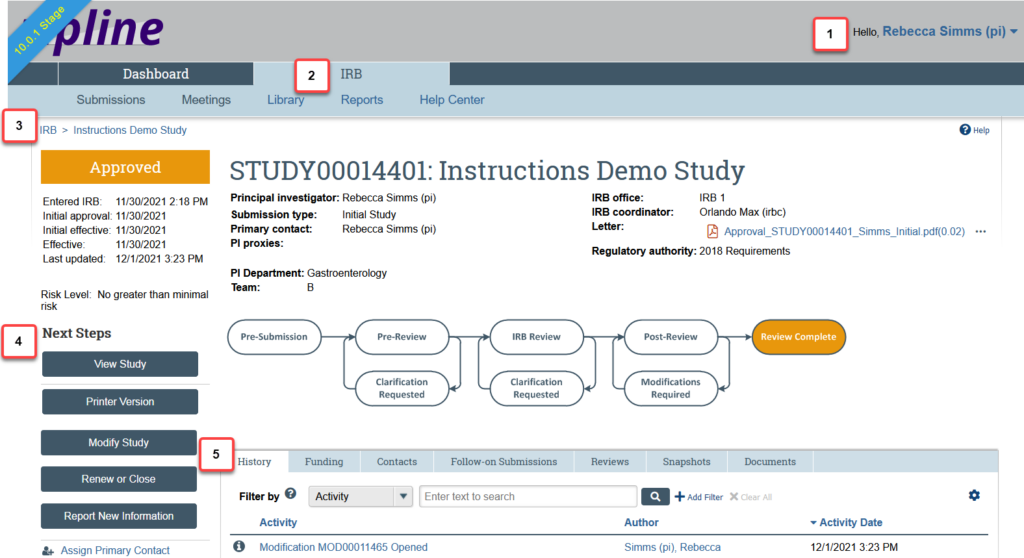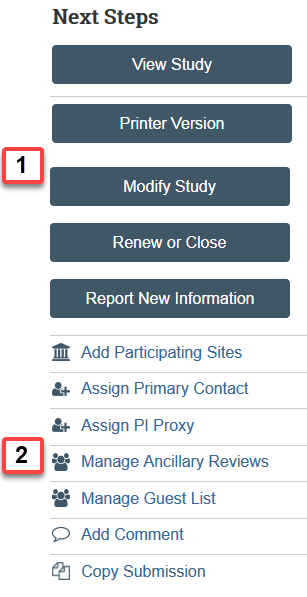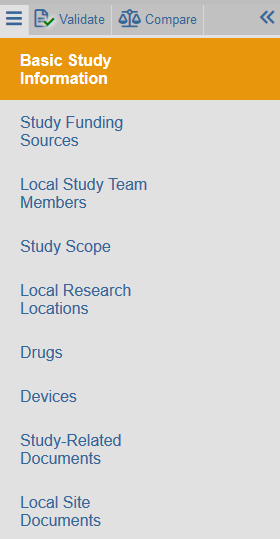Once you open a study, you see the study workspace. While there are minor differences depending on the submission type, the workspaces are very similar for all types of IRB submissions [1]. The workspace is your access point for:
- Viewing the application contents and details, including all actions performed on it
- Editing the study for applications that include you on the study team
- Performing actions on the application
Table of Contents
- Navigating the Workspace [2]
- Navigating SmartForms [3]
- Finding Study Documents [4]
- Navigating Between Studies and Follow-on Submissions [5]
- Navigating Between Studies and Sites [6]
Navigating the Workspace
The figure below identifies the key workspace elements that help you find your way around the IRB system and perform actions on the study.

The key elements shown are:
- Header: Provides links to your profile and lets you log off
- Top navigator: Provides links to the major sections of the system that you can access
- Breadcrumb navigator: Tracks your movement through the hierarchy of pages and enables you to quickly move back to a previous location
- Activities: Lets you take appropriate actions—such as viewing the study—based on the study’s current status
- Resource tabs: Gives access to collected study information, such as the study team membership, documents attached to the study, and older versions of the study
Basic Study Information

The Basic Study section is at the top of the screen and contains:
- The Study State [7]
- NOTE: For Not Human Research determinations, the type is also displayed- Not Research or Not Human Subjects.
- Dates and Approval Information
- Entered IRB: The date when the study went from “Pre-Submission” to “Pre-Review” and entered HSD’s queue for review.
- Initial Approval: The date when the study was first approved. For follow-on submissions, this date refers to the follow-on submission and not the parent study.
- Initial Effective: The date when the IRB decision initially took effect.
- Effective: The date when the IRB decision takes effect. The effective date is most significant when modifications are required before approval, because the research cannot start immediately when the IRB decision is made (the approval date). The effective date is set to the day the modifications are reviewed and accepted.
- Approval end: The end date of the approval period. If it is blank, the study approval does not expire.
- Last Updated: The most recent date when any change was made to the record.
- The Study ID number and Name: The study ID number is unique to the specific submission. The prefix for the ID number indicates the submission type. There is no relationship between the ID number for parent studies and follow-on submissions.
- The Submission Type: See the Submission Type section [1] for more detailed information on submission types.
- Key Contacts
- Principal Investigator and PI Proxy: The principal investigator (PI) for the study and anyone that the PI has designated as a proxy. The PI and PI proxy are the only people who can submit initial applications, continuing review, modifications, or responses to HSD on behalf of the study team.
- Primary Contact: The primary contact receives all notifications related to the study. This role is automatically assigned to the person who initially creates the study in the system, but it can be changed by the study team or HSD staff at any time.
- IRB Coordinator: The HSD reviewer assigned to handle the application from Pre-Review through Review Complete.
- Team: The assigned HSD team for the study.
- Letter: The most recent determination letter from HSD/the IRB. Note that this does not show up until a determination letter has been sent.
- Risk Level: The risk level of the study as a whole. The risk level for follow-on submissions reflects the risk level of the study, not the risk level of the follow-on submission.
- Regulatory Authority: The set of regulatory requirements that apply to the study. Pre-2018 Requirements indicates that the Original Common Rule applies, and 2018 Requirements indicates that the Revised Common Rule applies. If the FDA or DOJ have regulatory authority, this will also be noted.
Resources Tabs
The detailed study information is available under the basic study information. Additional information can be found by viewing the submission SmartForm. It is organized by tabs, and there will be variation in the tabs that are available depending on the type and state of the submission.

The most important tabs are:
- History: The record of every action that has happened in the life of the application. This tab can be filtered and sorted [8].
- Funding: Overview of all funding that has been added to the study.
- Contacts: List of all contacts for the study. For studies that were created before the 1/7/2020 upgrade, the Study Roles Addendum is available here for reference.
- Sites: For multi-site/collaborative studies only, this lists any site records for institutions with activities being reviewed by the UW IRB.
- Follow-on Submissions: Any follow-on submissions (modifications, continuing review, or reports of new information) that exist for the study.
- Reviews: The most recent review information, including any required ancillary review, such as faculty advisor review. The information you see in the reviews tab depends on your access and permissions [9].
- Snapshots: Historical snapshots of the application during various points in the life of the study.
- Documents: Most recent versions of all of the attached documents for the study.
Available Actions
Actions available to you will vary depending on your user role and the state of the submission.

- Top Buttons:
- View or Edit: This button allows you to open the SmartForm to view or edit (depending on the state and your permissions).
- Printer Version: Formats the SmartForm into one printer friendly document.
- Report New Information: Anyone can submit a report of new information.
- Buttons with Action Icons: The actions available to you. This will vary depending on the state and your user role.
Navigating SmartForms
Zipline applications consist of a SmartForm application and required attachments that are completed and uploaded to the SmartForm. Click View Study (or Edit Study) to see the SmartForm. The forms contain a consistent set of navigation options.
Left-hand Navigator
The navigator persists on screen, but can be collapsed if desired. It lists all the SmartForm steps, or pages, that are available for the application. The current step is highlighted. A back button is not available- instead simply click the link to go to the desired page.

Basic Actions
The Exit, Save, and Continue buttons maintain a fixed location in the bottom right portion of the screen as the user moves through the SmartForm steps.

The print button allows for printing the current step or the entire SmartForm.
![]()
Finding Study Documents
Once your study is approved in Zipline, you will always find the most current approved version of the study documents in the initial study record.
- When you submit a modification: The new version of any revised document, such as the IRB Protocol or consent form, is automatically pushed to the initial study record once the modification is approved.
- When you submit a continuing review: Any documents that are attached to a continuing review, such as the status report form, are not pushed to the initial study record. Instead, continuing review documents are available in the Documents tab of the continuing review.
See the Locating Studies [10] page if you need help locating the application.
1. Open the initial study record by clicking the study name
2. Go to the Documents tab
![]()
Documents are divided into 2 sections depending on where they were uploaded in the SmartForms- Study Related Documents and Site Related Documents.
*To find site-specific documents for a relying non-UW institution, go to the Documents tab in the related Site record.
**This contains all documents uploaded by the study team as a part of the application process and some documents uploaded by HSD staff, such as finalized Reliance Agreements and Information for Researchers.
3. Locate needed document
A. Category: All documents are sorted by category. Most documents are assigned a category based on where they are uploaded in the study SmartForm.
B. Draft: The draft version of the document contains any previous tracked changes.
C. Final: The final version of the document contains HSD’s watermark for any consent materials.
D. Last Finalized: The date that HSD last reviewed and approved the document.
E. Document History: Easily access any previously uploaded versions of the document.

Navigating Between Studies and Follow-on Submissions
Once a study is in Zipline, it may have follow-on submissions associated with it. Follow-on submissions, such as modifications or continuing review reports, do not stand alone but instead contain additional information about the parent study. For more information, see IRB Submission Types [1].
To Find Any Follow-on Submissions Associated with a Study:
1. From the study workspace, click on the Follow-on Submissions tab. Note that there may not be a Follow-on Submissions tab if there are not any follow-on submissions associated with the study.
![]()
2. Click on the name of the Follow-on submission to go to that submission’s workspace.
To Find the Parent Study from a Modification or Continuing Review workspace:
1. Use the link to the parent study provided in the follow-on workspace

To Find the Parent Study from a Report of New Information (RNI) workspace:
1. From the RNI workspace, click on the Related Submissions tab. Note that RNI may not have any related submissions.
![]()
2. Click the name of the related submission to go to that submission’s workspace.
Navigating Between Studies and Sites
Multi-site and collaborative studies have a main parent study record with additional site records for each involved institution.
To Find Sites Associated with a Study:
1. From the study workspace, click on the Sites tab
![]()
2. Click on the name of the site to go to the site’s workspace
To Find the Parent Study for a Site:
1. Click the link to the study in the site workspace
